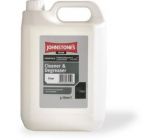
Paint Thinner
-

Johnstone's Cleaner and Degreaser
From:£56.49(inc VAT) -

Johnstone's TC1 Thinner & Cleaner
From:£72.49(inc VAT) -

Johnstone's TC3 Thinner & Cleaner
From:£77.49(inc VAT) -

Johnstone's Mordant Solution
From:£77.95(inc VAT) -

Coo-Var Brush Wash / Thinners
From:£35.95(inc VAT) -

Coo-Var Graffiti Remover
From:£15.95(inc VAT)multiple sizes
What is paint thinner?
A paint thinner is most commonly known as a solvent used to remove oil-based paint from brushes, rollers, equipment, or surfaces. However, there are other applications and uses for paint thinner. For example, you can use paint thinner to reduce the viscosity of paint so it can be used in sprayer applicators or you can use it to prevent paint from hardening when it has been left open.
It is advised to store paint thinners in a dry place below 40°C.
How to use paint thinner?
See the below tips of how to use paint thinner to achieve the best results:
Mix the thinner with paint that’s stored at room temperature.
Don’t use cold paint as it can affect the thickness and application process.
Use a wooden stick or spoon to mix the paint while adding the paint thinner.
Test the mix before starting by applying two coats of your paint thinner on your chosen surface. Ensure that the layer of paint is completely covering the surface and that you cannot see the surface underneath it. Also, make sure that the paint has a good consistency meaning it is not dripping but it’s also not too thick.
Remove any chunks of paint that cannot be mixed with the paint thinner.
If you find that after you have added thinner to the paint it is still too thick, try adding a little bit of water to it (only if it is latex paint though).
Remember not to leave the paint thinner open for too long, as it will evaporate.
Do not pour used thinner or oil-based paints into drains or onto the ground. This can pollute soil and water.
How to use paint thinner to clean brushes?
Before you start cleaning the brushes with the paint thinner, try to get the brush free of paint. You can do this either on the surface you’re painting, a cloth, paper towel or piece of newspaper.
Here are our recommended steps of how to clean brushes with paint thinner:
Firstly, rinse the brush thoroughly in paint thinner using a plastic bowl or other small container.
Stir the brush in the paint thinner for 10-30 seconds. Wipe the bristles against the side of the container when finished. Repeat until there is no more paint on the brush.
Clean the brush in a bucket of soapy water using a washing up liquid. Next, rinse the brush in warm water to remove any remaining soap from the brush.
Remove water from wet brushes by shaking them above a cardboard box or other container. Alternatively, you can use a brush spinner to spin the brush dry above a container. If the brush is still moisture, try blotting it on a newspaper, paper towel or clean cloth until the brush has dried.
Lastly, store the brushes on the flat surface or you can hang them with the bristles pointing down.






